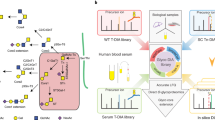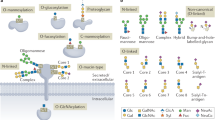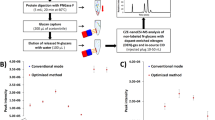Abstract
Quantitative proteome profiling using stable isotope protein tagging and automated tandem mass spectrometry (MS/MS) is an emerging technology with great potential for the functional analysis of biological systems and for the detection of clinical diagnostic or prognostic marker proteins. Owing to the enormous complexity of proteomes, their comprehensive analysis is an as-yet-unresolved technical challenge. However, biologically or clinically important information can be obtained if specific, information-rich protein classes, or sub-proteomes, are isolated and analyzed. Glycosylation is the most common post-translational modification. Here we describe a method for the selective isolation, identification and quantification of peptides that contain N-linked carbohydrates. It is based on the conjugation of glycoproteins to a solid support using hydrazide chemistry, stable isotope labeling of glycopeptides and the specific release of formerly N-linked glycosylated peptides via peptide- N-glycosidase F (PNGase F). The recovered peptides are then identified and quantified by MS/MS. We applied the approach to the analysis of plasma membrane proteins and proteins contained in human blood serum.
This is a preview of subscription content, access via your institution
Access options
Subscribe to this journal
Receive 12 print issues and online access
$209.00 per year
only $17.42 per issue
Buy this article
- Purchase on Springer Link
- Instant access to full article PDF
Prices may be subject to local taxes which are calculated during checkout




Similar content being viewed by others
References
Oda, Y., Huang, K., Cross, F.R., Cowburn, D. & Chait, B.T. Accurate quantitation of protein expression and site-specific phosphorylation. Proc. Natl. Acad. Sci. USA 96, 6591–6596 (1999).
Veenstra, T.D., Martinovic, S., Anderson, G.A., Pasa-Tolic, L. & Smith, R.D. Proteome analysis using selective incorporation of isotopically labeled amino acids. J. Am. Soc. Mass Spectrom. 11, 78–82 (2000).
Gygi, S.P. et al. Quantitative analysis of complex protein mixtures using isotope-coded affinity tags. Nat. Biotechnol. 17, 994–999 (1999).
Link, A.J. et al. Direct analysis of protein complexes using mass spectrometry. Nat. Biotechnol. 17, 676–682 (1999).
Rappsilber, J., Ryder, U., Lamond, A.I. & Mann, M. Large-scale proteomic analysis of the human spliceosome. Genome Res. 12, 1231–1245 (2002).
Zhou, Z., Licklider, L.J., Gygi, S.P. & Reed, R. Comprehensive proteomic analysis of the human spliceosome. Nature 419, 182–185 (2002).
Rout, M.P. et al. The yeast nuclear pore complex: composition, architecture, and transport mechanism. J. Cell Biol. 148, 635–651 (2000).
Fountoulakis, M., Berndt, P., Langen, H. & Suter, L. The rat liver mitochondrial proteins. Electrophoresis 23, 311–328 (2002).
Yi, E.C. et al. Approaching complete peroxisome characterization by gas-phase fractionation. Electrophoresis 23, 3205–3216 (2002).
Han, D.K., Eng, J., Zhou, H. & Aebersold, R. Quantitative profiling of differentiation-induced microsomal proteins using isotope-coded affinity tags and mass spectrometry. Nat. Biotechnol. 19, 946–951 (2001).
Bergquist, J., Gobom, J., Blomberg, A., Roepstorff, P. & Ekman, R. Identification of nuclei associated proteins by 2D-gel electrophoresis and mass spectrometry. J. Neurosci. Methods 109, 3–11 (2001).
Ficarro, S.B. et al. Phosphoproteome analysis by mass spectrometry and its application to Saccharomyces cerevisiae. Nat. Biotechnol. 20, 301–305 (2002).
Oda, Y., Nagasu, T. & Chait, B.T. Enrichment analysis of phosphorylated proteins as a tool for probing the phosphoproteome. Nat. Biotechnol. 19, 379–382 (2001).
Zhou, H., Watts, J.D. & Aebersold, R. A systematic approach to the analysis of protein phosphorylation. Nat. Biotechnol. 19, 375–378 (2001).
Spahr, C.S. et al. Simplification of complex peptide mixtures for proteomic analysis: reversible biotinylation of cysteinyl peptides. Electrophoresis 21, 1635–1650 (2000).
Haystead, C.M., Gregory, P., Sturgill, T.W. & Haystead, T.A. Gamma-phosphate-linked ATP-sepharose for the affinity purification of protein kinases. Rapid purification to homogeneity of skeletal muscle mitogen-activated protein kinase kinase. Eur. J. Biochem. 214, 459–467 (1993).
Adam, G.C., Sorensen, E.J. & Cravatt, B.F. Proteomic profiling of mechanistically distinct enzyme classes using a common chemotype. Nat. Biotechnol. 20, 805–809 (2002).
Varki, A. et al. Essentials of Glycobiology (Cold Spring Harbor Laboratory Press, Cold Spring Harbor, NY, 1999).
Bause, E. Structural requirements of N-glycosylation of proteins. Studies with proline peptides as conformational probes. Biochem. J. 209, 331–336 (1983).
Roth, J. Protein N-glycosylation along the secretory pathway: relationship to organelle topography and function, protein quality control, and cell interactions. Chem. Rev. 102, 285–303 (2002).
Shepard, H.M. et al. Monoclonal antibody therapy of human cancer: taking the HER2 protooncogene to the clinic. J. Clin. Immunol. 11, 117–127 (1991).
Durand, G. & Seta, N. Protein glycosylation and diseases: blood and urinary oligosaccharides as markers for diagnosis and therapeutic monitoring. Clin. Chem. 46, 795–805 (2000).
Freeze, H.H. Update and perspectives on congenital disorders of glycosylation. Glycobiology 11, 129R–143R (2001).
Spiro, R.G. Protein glycosylation: nature, distribution, enzymatic formation, and disease implications of glycopeptide bonds. Glycobiology 12, 43R–56R (2002).
Beardsley, R.L., Karty, J.A. & Reilly, J.P. Enhancing the intensities of lysine-terminated tryptic peptide ions in matrix-assisted laser desorption/ionization mass spectrometry. Rapid Commun. Mass Spectrom. 14, 2147–2153 (2000).
Eng, J., McCormack, A.L. & Yates, J.R. An approach to correlate tandem mass spectral data of peptides with amino acid sequences in a protein database. J. Am. Soc. Mass Spectrom. 5, 976–989 (1994).
Keller, A., Nesvizhskii, A.I., Kolker, E. & Aebersold, R. Empirical statistical model to estimate the accuracy of peptide identifications made by MS/MS and database search. Anal. Chem. 74, 5383–5392 (2002).
Yoshioka, Y. et al. The complete amino acid sequence of the A-chain of human plasma α2HS-glycoprotein. J. Biol. Chem. 261, 1665–1676 (1986).
Mills, P.B., Mills, K., Johnson, A.W., Clayton, P.T. & Winchester, B.G. Analysis by matrix assisted laser desorption/ionisation-time of flight mass spectrometry of the post-translational modifications of α1-antitrypsin isoforms separated by two-dimensional polyacrylamide gel electrophoresis. Proteomics 1, 778–786 (2001).
Baumann, U. et al. Crystal structure of cleaved human α1-antichymotrypsin at 2.7 A resolution and its comparison with other serpins. J. Mol. Biol. 218, 595–606 (1991).
Bobbitt, J.M. Periodate oxidation of carbohydrates. Adv. Carbohydr. Chem. 11, 1–41 (1956).
Bayer, E.A., Ben-Hur, H. & Wilchek, M. Biocytin hydrazide—a selective label for sialic acids, galactose, and other sugars in glycoconjugates using avidin-biotin technology. Anal. Biochem. 170, 271–281 (1988).
Geoghegan, K.F. & Stroh, J.G. Site-directed conjugation of nonpeptide groups to peptides and proteins via periodate oxidation of a 2-amino alcohol. Application to modification at N-terminal serine. Bioconjug. Chem. 3, 138–146 (1992).
Maley, F., Trimble, R.B., Tarentino, A.L. & Plummer, T.H., Jr. Characterization of glycoproteins and their associated oligosaccharides through the use of endoglycosidases. Anal. Biochem. 180, 195–204 (1989).
Griffin, T.J. et al. Quantitative proteomic analysis using a MALDI quadrupole time-of-flight mass spectrometer. Anal. Chem. 73, 978–986 (2001).
Griffin, T.J. et al. Abundance ratio-dependent proteomic analysis by mass spectrometry. Anal. Chem. 75, 867–874 (2003).
Gonzalez, J. et al. A method for determination of N-glycosylation sites in glycoproteins by collision-induced dissociation analysis in fast atom bombardment mass spectrometry: identification of the positions of carbohydrate-linked asparagine in recombinant α-amylase by treatment with peptide-N-glycosidase F in 18O-labeled water. Anal. Biochem. 205, 151–158 (1992).
Horoszewicz, J.S. et al. The LNCaP cell line—a new model for studies on human prostatic carcinoma. Prog. Clin. Biol. Res. 37, 115–132 (1980).
Bairoch, A. & Apweiler, R. The SWISS-PROT protein sequence database and its supplement TrEMBL in 2000. Nucleic Acids Res. 28, 45–48 (2000).
Nakai, K. & Horton, P. PSORT: a program for detecting sorting signals in proteins and predicting their subcellular localization. Trends Biochem. Sci. 24, 34–36 (1999).
Klein, P., Kanehisa, M. & DeLisi, C. The detection and classification of membrane-spanning proteins. Biochim. Biophys. Acta 815, 468–876 (1985).
Horton, P. & Nakai, K. Better prediction of protein cellular localization sites with the k nearest neighbors classifier. Proc. Int. Conf. Intell. Syst. Mol. Biol. 5, 147–152 (1997).
Aebi, M. & Hennet, T. Congenital disorders of glycosylation: genetic model systems lead the way. Trends Cell Biol. 11, 136–141 (2001).
Acknowledgements
This work was supported in part by grants from the National Cancer Institute (R33, CA93302) and by a sponsored research agreement from MacroGenics. The Institute for Systems Biology is supported by a generous gift from Merck & Co. D.B.M is supported by a National Institutes of Health career development award (K08CA97282-01).
Author information
Authors and Affiliations
Corresponding author
Ethics declarations
Competing interests
The authors declare no competing financial interests.
Supplementary information
Rights and permissions
About this article
Cite this article
Zhang, H., Li, Xj., Martin, D. et al. Identification and quantification of N-linked glycoproteins using hydrazide chemistry, stable isotope labeling and mass spectrometry. Nat Biotechnol 21, 660–666 (2003). https://doi.org/10.1038/nbt827
Received:
Accepted:
Published:
Issue Date:
DOI: https://doi.org/10.1038/nbt827
This article is cited by
-
The proteome of the blood–brain barrier in rat and mouse: highly specific identification of proteins on the luminal surface of brain microvessels by in vivo glycocapture
Fluids and Barriers of the CNS (2024)
-
Multiple circulating forms of neprilysin detected with novel epitope-directed monoclonal antibodies
Cellular and Molecular Life Sciences (2024)
-
Determination of ovalbumin sensing response of protein-imprinted bilayered hydrogel strips via measurement of mechanically driven bending angles based on swelling-induced deformation
Microchimica Acta (2023)
-
Use of MS-GUIDE for identification of protein biomarkers for risk stratification of patients with prostate cancer
Clinical Proteomics (2022)
-
Dissecting the essential role of N-glycosylation in catalytic performance of xanthan lyase
Bioresources and Bioprocessing (2022)



